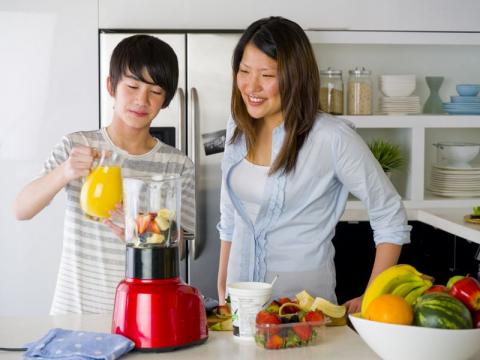Content Map Terms

Research shows that health and education are connected.
Children, whose physical, mental, social and emotional health is supported both at school and at home, are more likely to achieve their fullest potential.
As parents, you have a key role in supporting your children to form lifestyle habits that will build the foundation for them to live healthy, fulfilling and productive lives. In this section, you will find tips to help your child feel more connected, eat healthy and be physically active.
Feeling Connected
At Home
- Help your children with homework, and try to make sure they have the tools - school supplies, a quiet place - they need to do their homework.
- Encourage your children to help out at home, at school and in the community, such as helping with chores, preparing healthy snacks and meals, running errands, volunteering or tutoring younger students after school.
- Provide opportunities for your child to develop relationships with caring, responsible adults. Arrange for, or encourage, your child to spend time with an aunt, uncle, grandparent or other trusted adult with a shared interest.
At School
- Meet regularly with your children's teachers to discuss their grades, behaviour and accomplishments.
- FAST FACT: Children who feel a sense of belonging at school are more likely to do well, stay in school and make healthy choices.Offer to share unique aspects of your culture with your child's class.
- Get involved with your children's school; volunteer, go on school field trips, participate in school and community events.
- Encourage your child's school to adopt an anti-bullying policy, if they don't have one in place.
- Support your children to participate in school activities, such as organized sports, clubs or special events.
Students feel connected to school when they:
- Feel they are part of the school;
- Are happy and like school;
- Feel safe at school;
- Participate in school activities;
- Feel that teachers are fair and care about them; and
- Get along with other students (MacKay, 2009)
Healthy Eating
At Home

- Start the day with breakfast. Kids who eat breakfast regularly do better in school and are more likely to graduate.
- Kids are more likely to eat their lunch if they are involved in making it. Let them choose from a few healthy items using Eating Well with Canada’s Food Guide.
- If mornings are rushed then make lunches the night before. Visit the healthy eating section for healthy lunch ideas.
- Help your children limit sugar by offering water most often, limiting sugary drinks and offering only 1/2 cup per day of 100 per cent fruit juice for children and up to one cup per day for teens and adults. Learn more.
- Keep healthy snack foods on hand to make healthy snacking easy. For example, cut-up vegetables, whole fruit, cheese, whole grain crackers, hummus, whole grain pita or chapatti.
- Reducing your sodium intake is a key factor in healthy eating. Look for lower sodium snack ideas here.
- Cook together and eat together with your child. This will help develop food skills and provide fun opportunities for you to spend time together.
At School
- Encourage your school to support healthy eating by implementing the Guidelines for Food and Beverage Sales in BC Schools, registering with the BC School Fruit and Vegetable Nutritional Program or Action Schools! BC, or help your school set up a school food garden, salad bar or Farm to School program.
- Take advantage of the Healthy Fundraising for Schools guide to support fundraising activities that meet the Guidelines for Food and Beverage Sales in BC Schools.
- Develop good hand-washing habits, as frequent hand washing reduces the spread of cold and flu viruses.
DID YOU KNOW? Kids who eat well have improved brain development and mental abilities, increased self-esteem, reduced anxiety and less depression and hyperactivity.
Physical Activity

At Home
- Role model healthy exercise habits for your child and get the whole family active by walking the dog, family walks or bike rides.
- Limit your children's screen time to two hours per day or less. Explain to them that it's important to sit less and move more to maintain good health.
- Support your children to take part in after school sports, active recreation programs at your local community centre and walking or hiking groups.
- Play together with your child. This will provide great opportunities for both of you to get active.
Visit the Physical Activity section for more tips on fitting physical activity into your family's life.
At School
- Whenever possible, encourage your children to walk, ride, rollerblade or skateboard to school instead of driving them. You can even keep a record of the emissions here.
- Encourage your school to support physical activity by registering with Action Schools! BC or coordinate with other parents to set up a "walking school bus" or bicycle train program.
- Join, or help set up, a healthy school committee to help plan and implement healthy living programs at your child's school.
DID YOU KNOW? BC students who are physically active every school day are almost twice as likely to report satisfaction with their learning compared to those who are not physically active. (Source: Ministry of Education Research Brief: Association Between Achievement and Physical Activity, 2009/10)
Smoking Cessation
If you smoke, try to quit. Your teen is more likely to become a smoker if you smoke. Also, research shows that second hand smoke is dangerous to nonsmokers because it increases their risk of lung cancer. For resources to help you quit smoking, visit https://quitnow.ca/. If your child smokes, ask if your school has copies of Youth Smart Steps from QuitNow Services.
